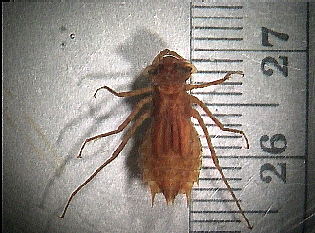 Aquatic Insects of Michigan
Aquatic Insects of Michigan
by Ethan Bright, Museum of Zoology Insect Division and School of Natural Resources and Environment
University of Michigan
- Home
- Species Lists
- Coleoptera
- Diptera
- Ephemeroptera
- Acanthametropodidae
- Ameletidae
- Ametropodidae
- Arthropleidae
- Baetidae
- Baetiscidae
- Behningiidae
- Caenidae
- Ephemerellidae
- Ephemeridae
- Heptageniidae
- Isonychiidae
- Leptohyphidae
- Leptophlebiidae
- Metretopodidae
- Neoephemeridae
- Oligoneuriidae
- Palingeniidae
- Polymitarcyidae
- Potamanthidae
- Pseudironidae
- Siphlonuridae
- Heteroptera
- Hymenoptera
- Lepidoptera
- Megaloptera
- Neuroptera (Sisyridae)
- Odonata
- Orthoptera
- Plecoptera
- Trichoptera
- Other Orders
- Keys/Identification
- Aquatic Insects of Michigan
Celithemis (Libellulidae) (Small Pennants) of Michigan - Identification
This group of attractively winged dragonflies are often familiar to almost everyone. Eight species of Celithemis are distributed in eastern North America (one extends west into the southwest), three species are found in Michigan.
Adults of our species have beautifully patterned wings and have a characteristic perching pattern on the tops of vertical stalks. Nymphs are clean, medium-sized, thin-legged, and delicate greenish and brown banded, they can be active on submerged vegetation or hiders among roots. Nymphs are distinguished from our other libellulids by the lack of middorsal spines on abdominal segment 8, and the long lateral spines of abdominal segments 8 and 9, the latter of which are twice the length of segment 8 and extend to or past the tips of the paraprocts. In fact, these characters together with the rather long length of the cerci (about 0.5x length of the paraproct) and the rather truncate shape of the end of the abdomen may confuse some with corduliids. However, Celithemis lack a distinct longitudinal medial groove at the base on the ventral surface, and the margin of the lateral lobes of the prementum are only finely crenate, with dentations much less pronounced than other corduliids.
Both C. elisa (Hagen, 1861) and C. eponina (Drury, 1773) are widely distributed in both peninsulas, whereas records for C. fasciata (Kirby, 1889) exist only for the southern LP. Nymphs are often found in lakes and ponds with aquatic vegetation, though sometimes specimens are taken from still or slow-moving sections of streams among macrophytes. In Michigan the emergence of adults occurs in June through early July, and exuvia are often found clinging to vegetation emerging up from water (Leonard 1934, pers. obs.). Life cycle of Celithemis is univoltine (Benke & Benke 1975, Wissinger 1988, Bright pers.obs).
Taxonomic references: Needham et al. 2010, Paulson 2011, Tennessen 2019, Walker and Corbet 1975
Adults
1a a. Wing membrane, except for dark spots, almost entirely transparent yellow, wing tips usually not dark Celithemis eponina (Drury) b. At least 2 rows of cells between veins M4 and Mpl 1b a. Wing membrane, except for dark spots, almost hyaline, wing tips dark 2 b. Only one row of cells between veins M4 and Mpl 3a(2a) a. Wings with the dark basal area not reaching the nodus Celithemis elisa (Hagen) b. Dark area betwen the nodus and pterostigma a subcircular spot generally not reaching the costa 3b a. Wings with the dark basal area reaching the nodus Celithemis fasciata Kirby b. Dark area between the nodus and pterostigma a transverse band reaching the costa
Mature Nymphs
1a a. Eyes tapering to an acutely conical, pointed tip Celithemis fasciata Kirby 1b a. Eyes protruding, but rounded laterally 2 2a(1b) a. Total length of mature nymph 17.0-19.3 mm Celithemis eponina (Drury) b. Width of abdomen at widest point 6.3-7.2 mm c. Paraproct length ≥ 1.40 mm d. Ab7 usually without a middorsal hook, rarely if present as long as 0.25 mm 2b a. Total length of mature nymph 13.5-17.0 mm Celithemis elisa (Hagen) b. Width of abdomen at widest point 4.7-5.5 mm c. Paraproct length < 1.35 mm d. Ab7 with a well-developed middorsal hook > 0.25 mm in length
References
Benke AC, Benke SS. 1975. Comparative dynamics and the life histories of coexisting dragonfly populations. Ecology 56: 302-317.
Leonard, J. W. 1934. The naiad of Celithemis monomelaena Williamson (Odonata: Libellulidae). Occasional Papers of the Museum of Zoology, University of Michigan 297. 5 pp.
Needham JG, Westfall MJ, May ML. 2010. Dragonflies of North America, Third Edition. Scientific Publishers, Gainesville, Florida, USA. xiv + 657 p.
Paulson D. 2011. Dragonflies and damselflies of the East. Princeton Field Guides. Princeton University Press, Pinceton, New Jersey, USA. 538 p.
Tennessen KJ. 2019. Dragonfly nymphs of North America: An Identification Guide. Springer International Publishing, Cham, Switzerland: xiv + 620 p.
Walker EM, Corbet JS. 1975. The Odonata of Canada and Alaska, Vol. 3. University of Toronto Press: Toronto, Ontario. xvi + 308.
Wissinger SA. 1988. Spatial distribution, life history and estimates of survivorship in a fourteen- species assemblage of larval dragonflies. Freshwater Biology 20: 329-340.
Page created: July 17, 1998 - Last updated: April 22, 2020 (EB)